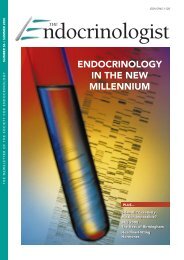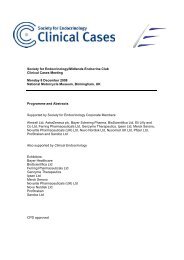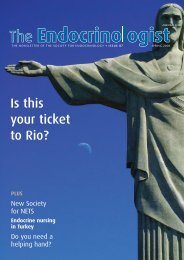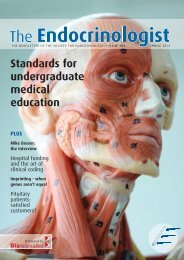Clinical Cases Meeting - Society for Endocrinology
Clinical Cases Meeting - Society for Endocrinology
Clinical Cases Meeting - Society for Endocrinology
- No tags were found...
Create successful ePaper yourself
Turn your PDF publications into a flip-book with our unique Google optimized e-Paper software.
<strong>Society</strong> <strong>for</strong><strong>Endocrinology</strong><strong>Clinical</strong> <strong>Cases</strong> <strong>Meeting</strong>Wednesday 21 February 2007The Royal <strong>Society</strong> of Medicine, 1 Wimpole Street, London W1G 0AEProgrammeandAbstractsSupported by <strong>Society</strong> <strong>for</strong> <strong>Endocrinology</strong> Premier Corporate Members:AstraZeneca PLC, BioScientifica Ltd, Ferring Pharmaceuticals Ltd,GlaxoSmithkline UK, Ipsen Ltd, Novartis Pharmaceuticals, Novo Nordisk Ltd,Pfizer, Sandoz International GmbH, Serono Pharmaceuticals Ltd and ShirePharmaceuticals LtdExhibitors:Novartis PharmaceuticalsNovo Nordisk LtdCPD approved
Forthcoming <strong>Society</strong> events:2007<strong>Society</strong> <strong>for</strong> <strong>Endocrinology</strong> BES 20075 – 8 March 2007ICC, Birmingham, UKEndocrine Nurses Training Course4 - 6 September 2007University of Glasgow, UK<strong>Clinical</strong> Update 20075 - 7 November 2007Victoria & Albert Hotel, Manchester, UK2008<strong>Society</strong> <strong>for</strong> <strong>Endocrinology</strong> BES 20087 – 10 April 2008Harrogate International Centre, UKAny comments on <strong>Clinical</strong> <strong>Cases</strong> <strong>Meeting</strong>s would be welcomed by Dr Stephen Ball(Programme Advisor to the SFE <strong>Clinical</strong> Committee), School of <strong>Clinical</strong> MedicalSciences, The Medical School, 4th Floor William Leech Building, Newcastle uponTyne NE2 4HH.Tel: 0191 232 5131, Fax: 0191 222 0723, Email: steve.ball@nuth.northy.nhs.ukThis meeting is accredited <strong>for</strong> 4 hours CPD
<strong>Society</strong> <strong>for</strong> <strong>Endocrinology</strong><strong>Clinical</strong> <strong>Cases</strong> <strong>Meeting</strong>13.30 – 14.00 Coffee and RegistrationCase DiscussionsChairman:Lecture TheatreDr Steven Ball14.00 – 14.30 POSTER VIEWING (Atrium)14.30 – 14.45 Is there a place <strong>for</strong> pegvisomant in the treatment algorithm of pituitary gigantismin childhood?Wong S C, Ahmed S FBone and Endocrine Research Group, Royal Hospital <strong>for</strong> Sick Children,Glasgow14.45 – 15.00 Panhypopituitarism and cranial diabetes insipidus in association withretroperitoneal fibrosisTait K F 1 , Walsh A R 2 , Toogood A A 1Department of <strong>Endocrinology</strong> 1 , Department of Neurosurgery 2 , UniversityHospital (Queen Elizabeth), Birmingham15.00 – 15.15 “Harmless Hypercalcaemia” across three generations in a Donegal family?O’Shea L A 1 , Callaghan P B 2 , Gallagher S 3 , Stack A G 1Departments of Renal Medicine 1 , General Medicine 2 , Paediatrics 3 , LetterkennyGeneral Hospital, Letterkenny, Co. Donegal, Republic of Ireland15.15 – 15.30 Pituitary hypoplasia and growth hormone deficiency in a child with cerebralvasculitis: Atypical single pathology or just bad luck?McDevitt H 1 , Horrocks I 2 , Ahmed S F 1Bone and Endocrine Research Group, Royal Hospital <strong>for</strong> Sick Children,Glasgow 1 Fraser of Allander Neurosciences Unit, Royal Hospital <strong>for</strong> SickChildren, Glasgow 215.30 – 15.45 Query Addison's disease - a case of familial glucocorticoid deficiencyMagee G M, Thiraviaraj A, Courtney C H, Hunter S JRegional Centre <strong>for</strong> <strong>Endocrinology</strong> and Diabetes, Royal Victoria Hospital,Belfast
15.45 – 16.00 Two cases of “idiopathic” hypopituitarism – was more intensive investigationrequired?Lewis A S, Courtney C H, Atkinson A BRegional Centre <strong>for</strong> <strong>Endocrinology</strong> and Diabetes, Royal Victoria Hospital,Belfast16.00 – 16.30 POSTER VIEWING and afternoon tea (Atrium)16.30 – 16.45 Emergency management of life-threatening hypercalcaemiaLee M C, Brooke A M, Chesser A M S, Al-Mufti R, Drake W MDepartments of <strong>Endocrinology</strong>, Nephrology and Surgery, St Bartholomew’sHospital, London16.45 – 17.00 Dilemmas in the management of macroprolactinoma with co-existentschizophreniaCaputo C, Wren A M, Meeran K, Hatfield E C ICharing Cross and Hammersmith Hospital Endocrine Unit, Imperial CollegeFaculty of Medicine17.00 – 17.15 Take it with a pinch of saltGangopadhyay K K, Gautam N, Gupta R, Toogood A AUniversity Hospital Birmingham NHS Foundation Trust17.15 – 17.30 “Diffuse idiopathic pulmonary neuroendocrine cell hyperplasia presenting asCyclical Cushings Syndrome”Carty D M, Connell J MWestern Infirmary, Glasgow17.30 Wine Reception (Atrium)Award of the <strong>Clinical</strong> <strong>Endocrinology</strong> Trust Prizes of £250 <strong>for</strong> first prize and£150 <strong>for</strong> the second prize <strong>for</strong> the best oral presentation and two prizes of £100<strong>for</strong> the best poster presentation by authors below consultant grade.
<strong>Society</strong> <strong>for</strong> <strong>Endocrinology</strong>TRAIINIING FORENDOCRIINOLOGIISTSwww.endocrinology.org<strong>Clinical</strong>The <strong>Society</strong> is pleased to announce an increase in training <strong>for</strong> clinicians<strong>Clinical</strong> Update Series5 – 7 November 2007ManchesterThe establishment of a <strong>Clinical</strong> Update Series. This will take the <strong>for</strong>m of a 3day meeting aimed at trainees and young consultants. This training will bebased on the national curriculum and will be the premiere endocrine trainingmeeting in the UK.An increase in the number and frequency of <strong>Clinical</strong> <strong>Cases</strong> <strong>Meeting</strong>s. The<strong>Society</strong> plans to open up the event to a national level, to reach as manytrainees as possible.Basic ScienceAn increase in basic science education content in the annual springmeeting. Improved education resources on the website.Contact: Shirine Borbor/Suzannah VarmaTel: +44(0)1454 642210Email: conferences@endocrinology.org
Is there a place <strong>for</strong> pegvisomant in the treatment algorithm of pituitary gigantism inchildhood?Wong S C, Ahmed S FBone and Endocrine Research Group, Royal Hospital <strong>for</strong> Sick Children, GlasgowA 5 year boy presented with a 2 week history of right divergent squint and reduced visualacuity on the background of rapidly increasing growth, 35cm over 2 years (Height SDS 6.2,target height SDS 1.2, tanner stage 1). At presentation he was also noted to have multiple caféau lait spots, some smooth edged and some crinkly. At diagnosis high GH 1114mU/L, IGF183.3nmol/L(7-38) and prolactin 1020mU/L were detected. MRI revealed a pituitary tumour inthe suprasellar region measuring 4x5cm with haemorrhage in the tumour. The tumour abuts theleft cavernous sinus and on the right encases a portion of the right carotid artery and basilarartery making curative surgery difficult. Histopathology confirmed pituitary adenoma of themammosomatotroph group. He underwent debulking surgery <strong>for</strong> pituitary apoplexy andcommenced treatment with dopamine agonist, carbegoline in the immediate post operativeperiod. GH levels were reduced to 382mU/L, prolactin suppressed but IGF1 levels remainedelevated 119nmol/L. Radiotherapy (45Gy in 25 fractions) using 3 field CT planned techniquewas per<strong>for</strong>med after a year after diagnosis as there was continual linear growth (Height SDS6.2, height velocity SDS 7.0 over 6 months previously) and continual GH (872mU/L) and IGF1(9.1SD) hyper secretion despite being on carbegoline and octreotide. He developed TSH andACTH deficiency within 3 months of radiotherapy. However there was ongoing evidence ofGH and IGF1 hyper secretion in the year following radiotherapy (IGF1 7.2 SD) and continuallinear growth (Height SDS 6.3). Over the last 6 months whilst there is no obvious slowingdown of linear growth, there is a trend towards gradual reduction of IGF1 levels (IGF1 SDS4.7). Pegvisomant, a GH receptor antagonist, which has been shown to be effective in thecontrol of GH and IGF1 in acromegaly has been considered in our patient. 2 paediatric casereports suggest that pegvisomant is successful in normalising IGF1 and slowing growth in GHsecreting tumours (Horm Res 2006;65:1-5,Eur J Endocrinol 2005;153:195-201) with noevidence of abnormal liver function as reported in adults with acromegaly. The underlyingaetiology of our patient’s pituitary gigantism is still unclear, although it is felt that McCuneAlbright Syndrome is a possibility. There is no family history of gigantism or endocrinetumours. Both parents have no skin stigma. Echocardiogram showed no evidence of cardiacmyxoma, skeletal survey showed no evidence of polyostotic fibrous dysplasia. Genetic studieshave been negative <strong>for</strong> the NF1 gene (blood), GNAS mutation (pituitary sample) and mutationin the PRKAR1A gene is awaited.Our patient there<strong>for</strong>e poses the following diagnostic and management questions:1. Is there a role of pegvisomant in our patient in the context of significantly elevated IGF1(although there is a trend towards recent improvement)?2. Does the continual hyper secretion of GH and IGF1 in our patient predispose to future risk ofmalignancy and insulin resistance and would there there<strong>for</strong>e be need <strong>for</strong> more aggressivetreatment?3. Is there a role of sex steroid and /or surgery in the peripubertal period to reduce lineargrowth?4. Are there further investigations to help clarify the aetiology of our patient’s gigantism?
Panhypopituitarism and cranial diabetes insipidus in association with retroperitonealfibrosisTait K F 1 , Walsh A R 2 , Toogood A A 1Department of <strong>Endocrinology</strong> 1 , Department of Neurosurgery 2 , University Hospital (QueenElizabeth), BirminghamA 41 year old man presented in May 2006 with a six month history of severe, localised leftretro orbital headache and vomiting. He also reported loss of libido, reduced beard growth andweight loss together with extreme lethargy, thirst and polyuria. Endocrine investigationsconfirmed panhypopituitarism and cranial diabetes insipidus and he was commenced onHydrocortisone replacement, Levothyroxine, Testosterone and Desmopressin. Pituitary MRIscan revealed diffuse enlargement of the pituitary gland which extended into the left cavernoussinus causing significant compression of the left carotid artery. A left parasellar soft tissuemass measuring 1.5 x 1 x 1 cm was also present. The optic chiasm was elevated, appearancesof the right cavernous sinus and parasellar area were normal. The appearances were not typicalof a pituitary adenoma. The patient underwent a trans-sphenoidal biopsy of the mass.Histological examination showed non specific inflammatory changes with lymphocyticinfiltration and fibrosis. The patient had presented in 2003 with bilateral leg swellingsecondary to thrombosis of the inferior vena cava. CT examination of the abdomendemonstrated a retroperitoneal mass encroaching on the IVC. Biopsies of the mass obtained byCT guided needle aspiration showed an inflammatory sclerosing process with no evidence ofmalignancy. There was no progression of the retroperitoneal mass on serial scans and thepatient had remained well until the end of 2005. There were no risk factors <strong>for</strong> fibrosis such asdrug or radiation exposure, immunological investigations and inflammatory markers have beenunremarkable.The unifying diagnosis in this case is multifocal fibrosclerosis, a rare idiopathic conditionoccurring in middle age resulting in inflammation and fibrosis at multiple sites. The cause isunclear although associations have been postulated with connective tissue diseases, pergolidetreatment, herpes virus infection and methylsergide. Medical treatments tried with variableresults include glucocorticoids, immunosuppressant agents (cyclosporine andcyclophosphamide) and radiotherapy. Retroperitoneal fibrosis, Riedel’s thyroiditis, orbitalpseudotumours with cavernous sinus invasion, mediastinal fibrosis, sclerosing cholangitis andpachymeningitis are a few of the manifestations reported in multifocal fibrosclerosis. Fibrosingpseudotumours involving the sella and surrounding area resulting in panhypopituitarism anddiabetes insipidus are a rare occurrence with less than 10 cases reported in the literature.Interestingly, all published cases with endocrine complications are males presenting in the 5 th or6 th decade of life. Our case illustrates the importance of long term follow up of patientsdiagnosed with an apparently localised idiopathic fibrosing process which may actually be thefirst presentation of this rare multisystem disorder.
“Harmless hypercalcaemia” across three generations in a Donegal family ?O’Shea L A 1 , Callaghan P B 2 , Gallagher S 3 , Stack A G 1Departments of Renal Medicine 1 , General Medicine 2 , Paediatrics 3 , Letterkenny GeneralHospital, Letterkenny, Co. Donegal, Republic of IrelandFamilial Hypercalcaemic Hypocalciuria (FHH), originally described in 19661, is an autosomaldominant disorder characterised by modest elevation of the serum calcium concentration that isgenerally asymptomatic, relative hypocalciuria and PTH levels not suppressed byhypercalcaemia and are inappropriately normal2,3 It was first linked to mutations in theCalcium-Sensing Receptor (CaSR) gene in 1993. Two thirds of FHH kindreds described to dateresult from inactivating mutations affecting a single allele on chromosome 3. The calciumsensingreceptor is a 1078 amino acid cell surface-expressed G protein-coupled receptor.Mutations are typically single-point in nature resulting in an elevated set-point <strong>for</strong> calciumsensing with mild to moderate hypercalcaemia, lower than expected urinary calcium andnormal PTH levels.The index case was a 61 year old grandfather referred with epigastric pain. An incidentalfinding of hypercalcaemia with corrected calcium of 2.72 mmol/l (NR 2.10-2.60), phosphate0.78 mmol/l (NR 0.87-1.45), magnesium low-normal 0.72 mmol/l (NR 0.70-1.05) and PTH53.87 pg/ml (NR 15-65). Screening <strong>for</strong> an underlying malignancy (gastrointestinal, prostate andmyeloma) proved negative. Retrospectively, he reported prior episodes of confusion andlongstanding poor memory. His daughter had a parathyroidectomy in another hospital withrecurrent abdominal pain dyspepsia and cholelithiasis <strong>for</strong> three years postoperatively. Markedhypercalcaemia of 3.08 mmol/l with PTH 58 pg/ml, was detected in his granddaughter at Day 1postnatally. Under close supervision by our paediatric colleagues her serum calcium over thepast six months remains > 3 mmol/l despite a low-calcium Baby Formulas.Patients with FHH have normal life expectancy (>90years) with most families developing nocomplications. Phenotypic diversity between kindreds includes severe pancreatitis withincreased risk of cholelithiasis, diabetes and myocardial infarction 3 . This family branch isparticularly interesting as it allows exploration of the phenotypic expressions of the CaSR genebut also the diagnostic dilemma in the granddaughter; FHH versus Neonatal SevereHyperparathyroidism, an association has been described between them 4,5,6 .1. Jackson CE, Boonstra CE. The relationship of hereditary hyperparathyroidism to endocrineadenomatosis. Am J Med 1967 Nov;43(5):727-34.2. Marx SJ, Lasker RD (1981) The hypocalciuric or benign variant of familial hypercalcaemic hypocalciuria: clinical & biochemical features of fifteen families. Medicine 60: 397-412.3. Law WM, Heath H III (1985) Familial Benign hypercalcaemia (hypocalciuric hypercalcaemia) : clinicaland pathogenetic study of 21 families. Ann Intern Med; 102:511-519.4. Marx SJ, Fox M (1982) An association between NSPTH & FHH in 3 Kindreds N Eng J Med 306:257-264.5. Cole DEC, Salisbury SR (1990) Primary Neonatal Hyperparathyroidism: a devastatingneurodevelopmental disorder if left untreated J Craniofac Genet Dev Biol 10:205-214.6. Pollak MR,Seidman JG (1994) FHH and NSPTH. Effects of mutant gene dosage on phenotype J ClinInvest 93:1108 – 1112
Pituitary hypoplasia and growth hormone deficiency in a child with cerebral vasculitis:Atypical single pathology or just bad luck?McDevitt H 1 , Horrocks I 2 , Ahmed S F 1Bone and Endocrine Research Group, Royal Hospital <strong>for</strong> Sick Children, Glasgow 1 , Fraser ofAllander Neurosciences Unit, Royal Hospital <strong>for</strong> Sick Children, Glasgow 2A 1 year old boy admitted to his local district general hospital with RSV infection was noted tobe failing to thrive. His height and weight were both markedly below the 0.9 th centile. A termdelivery, his birthweight was 3.7kg (90 th centile) and birth length was 32cm (below 0.9 th centile.)He had required phototherapy after birth <strong>for</strong> jaundice 2 0 to ABO incompatibility, and his onlyother medical history was of eczema. His development was satisfactory and there was nosignificant family history. Positive findings on examination were mild facial dysmorphism andrelatively short upper and lower limbs. Investigations in his local hospital revealedhypothyroidism (FT4 9nmol/l, TSH 2.1 Mu/l) and an undetectable IGF-1 (
Query Addison’s disease -a case of familial glucocorticoid disease.Magee G M, Thiraviaraj A, Courtney C H, Hunter S JRegional Centre <strong>for</strong> <strong>Endocrinology</strong> and Diabetes, Royal Victoria Hospital, Grosvenor Road,BelfastA 2 yr old boy presented initially with hypoglycaemia following a 6h fast prior to an electivesurgical procedure. Investigations demonstrated low plasma glucose (1.6mmol/l), elevated betahydroxybutyrate (5.2mmol/l), normal lactate and a detectable serum insulin level (2.5mu/l).Plasma amino-acid profile was normal. The dorsum of his hands were pigmented, however asynacthen test demonstrated a normal cortisol response. Ketotic hypoglycaemia wasdiagnosed, and his parents were given dietary advice. At age 11, he was referred to medicalgenetics with poor coordination and delayed fine motor skills and a dysmorphic appearance.Chromosomal analysis revealed a normal male karyotype, and no specific diagnosis was made.He presented at age 18 to our unit with recurrent hypoglycaemia. A 72h fast was terminatedafter 10 h as the patient was symptomatic with plasma glucose 1.6mmol/l. A synacthen testdemonstrated an absent cortisol response, and elevated ACTH level.Serum electrolytes were normal, adrenal auto antibodies were absent and very long chain fattyacids were normal. He was commenced on both glucocorticoid and mineralocorticoidreplacement and had no further hypoglycaemic episodes.The patients brother also presented at age 15 with hypoglycaemia following routine surgery. Adiagnosis of primary adrenal insufficiency was confirmed also with normal serum electrolytesand absent adrenal auto antibodies.Further genetic analysis revealed that both brothers were homozygous <strong>for</strong> the S74I mutation ofthe MC2 ( melano corticotrophin 2) receptor and a diagnosis of Familial GlucocorticoidDeficiency (FGD) was made. This rare autosomal recessive ACTH insensitivity syndromeresponds to glucocorticoid replacement alone.This particular case highlights some diagnostic dilemmas in an unusual presentation of primaryadrenal insufficiency. It is interesting that the original synacthen test in the first brother wasnormal despite classical symptoms. It only became diagnostic years later. This case alsoillustrates some dysmorphic features not typically described with this particular ACTH receptormutation.
Two cases of “idiopathic” hypopituitarism – was more intensive investigation required?Lewis A S, Courtney C H, Atkinson A BRegional Centre <strong>for</strong> <strong>Endocrinology</strong> and Diabetes, Royal Victoria Hospital, BelfastHypopituitarism usually occurs as the result of a pituitary tumour or as a consequence of itstreatment. If, however, pituitary imaging is negative then an alternative diagnosis should besought. We present two patients initially diagnosed as idiopathic hypopituitarism in whom anunderlying specific diagnosis was delayed with potentially serious consequences.The first case was of a 32 year old male who presented with symptoms of hypogonadism.<strong>Clinical</strong>ly he appeared hypogonadal. Serum testosterone (
Prescribing In<strong>for</strong>mationNORDITROPIN ® SIMPLEXX ®(somatropin (epr))Presentations: Norditropin SimpleXx 5mg/1.5ml (somatropin (epr) 5mg),Norditropin SimpleXx 10mg/1.5ml (somatropin (epr) 10mg), Norditropin SimpleXx15mg/1.5ml (somatropin (epr) 15mg) <strong>for</strong> use only with NordiPen ® 5, 10 and 15respectively. Uses: Growth failure due to growth hormone (GH) insufficiency,Turner’s syndrome or prepubertal chronic renal disease. Growth disturbance(current height SDS
Emergency management of life-threatening hypercalcaemiaLee M C, Brooke A M, Chesser A M S, Al-Mufti R, Drake W MDepartments of <strong>Endocrinology</strong>, Nephrology and Surgery, St Bartholomew’s Hospital, WestSmithfield. LondonA 54 year old lady presented to her local hospital with a ruptured quadriceps tendon after amechanical fall. Routine blood tests revealed corrected calcium (cCa) 4.44mmol/L, mild renalfailure, anaemia and thrombocytopenia. Despite intravenous fluids and bisphosphonateinfusion, the lowest calcium achieved was 4.02mmol/L. She underwent repair of her quadricepstendon, but declined further in-patient investigation.She re-presented 8 weeks later with a generalised tonic clonic seizure and a cCa 4.55mmol/L.She was treated with intravenous fluids, bisphosphonates and calcitonin. Parathyroid hormone(PTH) was 188pmol/L (1.1-6.8 pmol/l). She again declined in-patient treatment and wasmanaged as an outpatient with weekly bisphosphonate infusions.A month later, she re-presented with weakness, confusion, a sacral pressure sore, peripheraloedema, raised venous pressure, lateral Q waves on ECG and a cCa 5.82 mmol/L. She wasgiven further intravenous fluids and transferred to St Bartholomew’s Hospital. Investigationsrevealed anaemia (Hb 7.7g/dl), thrombocytopaenia (platelet count 33 x 10 9 /L), renal failure(urea 7.6mmol/L and creatinine of 155umol/L) and a cCa 4.80mmol/L. In view of her limitedresponse to optimal fluid replacement, loop diuretics, bisphosphonates and calcitonin andpersistent hypercalcaemia (>4 mmol/L), she underwent continuous haemofiltration <strong>for</strong> 7 days,with a zero calcium concentration in the substitution fluid. On haemofiltration, her cCa fell to anadir of 3.02mmol/L. She had a bone marrow aspirate and trephine biopsy which excludedmultiple myeloma and it was felt that she had some degree of bone marrow suppressionsecondary to severe hypercalcaemia.CT scan of her neck showed an extensive mass consistent with a parathyroid carcinoma, whichwas adherent to the carotid sheath, oesophagus and right lower thyroid lobe. A totalparathyroidectomy and total thyroidectomy was undertaken. Histology confirmed parathyroidcarcinoma extending to, but not beyond, the surgical margins.Post-operatively, her cCa fell to a nadir of 1.62mmol/L and she received intravenous calciumreplacement and was started on oral calcium and alfacalcidol 0.5mcg/day. PTH level fell to0.5pmol/L. Haemoglobin and platelets have shown some recovery. She is currently well 2 and ahalf years post parathyroidectomy, and is followed up with regular clinical review. Serum PTHhas remained less than 2pmol/L.The case will serve as a focus <strong>for</strong> the discussion on the emergency management of lifethreateninghypercalcaemia, where standard resuscitation and treatment measures have failed.
Dilemmas in the management of macroprolactinoma with co-existant schizophreniaCaputo C, Wren A M, Meeran K, Hatfield E C ICharing Cross and Hammersmith Hospital Endocrine Unit, Imperial College Faculty ofMedicine, LondonA 35 year old male was referred to our hospital in December 2003 after a seizure resulting in afall. CT brain showed a parietal contusion and incidentally a large pituitary macroadenomaexpanding the pituitary fossa. Definition of the pituitary lesion was poor, but the patientdeclined further imaging. His past history included epilepsy and schizophrenia, requiringpsychiatric inpatient treatment. Medications included olanzapine and phenytoin. Prolactin wasmarkedly elevated at 78,438 mU/L (NR 50-400). Other baseline pituitary function was normal.Perimetry showed bilateral temporal hemianopia, however cooperation was variable.He was carefully commenced on carbergoline, 500mcg weekly under psychiatric inpatientreview. Olanzapine was changed to quitiapine which exhibits less D2 antagonism. After 2weeks on cabergoline, the prolactin reduced to 16, 000 mU/L.Eight months post-discharge compliance deteriorated along with his psychiatric conditionrequiring psychiatric admission. Cabergoline was maintained at 500mcg weekly, and nadirprolactin was 1000-3000 mU/L. Transphenoidal surgery was contemplated to allow definitivecure, withdrawal of dopamine antagonist and more aggressive treatment of his schizophrenia.However, this was balanced against the risks of possible panhypopituitarism, including diabetesinsipidus, and the difficulties likely to be encountered in managing hormone replacement in theface of psychiatric co-morbidity. After multiple failed attempts to re-image his pituitary, recentimprovement in his psychiatric condition allowed an MRI under anaesthesia. This showedsignificant reduction of tumour mass. Fortunately, he does not currently require surgery;however, life long multidisiplinary care will be required.This case highlights some of the challenges in managing prolactinoma in patients withschizophrenia, including exacerbation of each disease by the medication used to treat the otherand erratic compliance with medication and monitoring. However, close multidisciplinaryliaisons can achieve successful outcomes. It is well recognised that dopamine agonists used inthe treatment of schizophrenia cause hyperprolactinemia. In addition, recent pharmacovigilancestudies have now noted a strong association of antipsychotics including olanzpine withprolactinomas and this data will be discussed in relation to our patient.
Take it with a pinch of saltGangopadhyay K K, Gautam N, Gupta R, Toogood A AUniversity Hospital Birmingham NHS Foundation Trust, BirminghamA 22 year old male was admitted at 1.00 am on 27 th July, 2006 after his mother found himcollapsed on the floor “blue and not breathing”. He was resuscitated by paramedics andadmitted to medical admissions unit. On admission his Glasgow coma scale was 11/15(M5E3V3). BP 129/69,Pulse 80/min, temp=36.1 ºC, general examination was unremarkableand there was no focal neurological deficit. Initial biochemical assessment demonstrated Na=115mmol/L, K=1.5mmol/L, Urea=5.6, Creatinine=116, serum osmolality=241 mosm/L,urineosmolality=160. The urine sodium was
“Diffuse idiopathic pulmonary neuroendocrine cell hyperplasia presenting as cyclicalCushings Syndrome”Carty D M, Connell J MWestern Infirmary, GlasgowWe present the case of a 76 year old woman who was admitted to our hospital with severeCushings syndrome, in association with hair loss and hypokalaemia (serum potassium 1.6mmol/l.) Plasma cortisol levels were elevated, and did not suppress with high dosedexamethasone. ACTH levels were detectable throughout the HDDST. MRI pituitary and CTadrenals were normal, but CT of chest revealed an area of nodularity in the right lung. With nospecific treatment her symptoms settled, and her biochemistry returned to normal.Three months later her symptoms recurred, and she was again found to have elevated plasmacortisol and ACTH levels with low serum potassium. Petrosal sinus and peripheral venoussampling did not identify a clear source of ACTH release. CT chest revealed an area ofnodularity in the right lung. Endotracheal bronchoscopy was normal, but pathology of transbronchialbiopsy showed features in keeping with diffuse pulmonary neuro-endocrine cellhyperplasia. Her symptoms of Cushings syndrome failed to settle with medical therapy, andultimately she proceeded to bilateral laparoscopic adrenalectomy, with full resolution of thefeatures of cortisol excess.Subsequent Video Assisted Thoracic Surgery (VATS) revealed diffuse nodularity throughoutthe right lung. Wedges were taken from middle and lower lobes, and pathology demonstrateddiffuse neuroendocrine cell hyperplasia, with positive immunohistochemistry <strong>for</strong> ACTH. Sheremains symptomatically well since bilateral adrenalectomy. ACTH levels remain detectable,and she is currently being treated with a sustained release somatostatin analogue.Diffuse Idiopathic Pulmonary Neuroendocrine Cell Hyperplasia (DIPNECH) is a rarepulmonary condition which was first described in 1992. Pathology represents a spectrum ofcellular hyperplasia ranging from neuro-endocrine cell proliferation to discrete masses greaterthan 5mm, which may be defined as carcinoid tumours. Little is known of its clinical course ortreatment options. This case represents a patient with intermittent ectopic ACTH releasepresenting as cyclical Cushings syndrome from DIPNECH rather than from a discrete carcinoidlesion. This association has not previously been recognised.
POSTER PRESENTATIONS1. 33year old male with untreated hypopituitarism due to a suprasellar arachnoid cystAdetunji O R 1 , Blair J 2 , Javadpour M 3 , MacFarlane I A 4Diabetes and <strong>Endocrinology</strong> Research Group 1 , University Hospital Aintree, Liverpool 2 , Dept.of <strong>Endocrinology</strong>, Alder Hey Children’s Hospital, Liverpool 3 , Walton Centre <strong>for</strong> Neurologyand Neurosurgery, Liverpool 42. PPNAD – Diagnostic and therapeutic challengesBoyd D S T, Ahmed S FBone & Endocrine Research Group, Royal Hospital <strong>for</strong> Sick Children, Glasgow, UK3. Autoimmune polyendocrinal deficiency syndrome type IIButt M I 1 , Phillips S 1 , Robinson A M 2Specialist Registrar Diabetes/<strong>Endocrinology</strong> 1 , Consultant Endocrinologist 2 , Royal UnitedHospital, Bath4. Routine screening tests reveal an asymptomatic somatotropin and thyrotropin secretingpituitary adenoma: Management options result in open discussion of the ethics of primarymedical therapy with somatostatin analogues.Cavlan D 1 , Crown A 2SHO <strong>Endocrinology</strong> 1 , Consultant Endocrinologist 2 Royal Sussex County Hospital, BSUHNHS Trust, Brighton, Sussex5. Should a prophylactic thyroidectomy be per<strong>for</strong>med in an asymptomatic patient with a historyprimary hyperparathyroidism at aged 17 years and a persistently elevated calcitonin level?Caputo C, Todd J FEndocrine Unit, Imperial College Faculty of Medicine, Hammersmith Hospital, Du CaneRoad, London W12 0NN, UK6. Pituitary apoplexy or something more?Chung T T, Berney D, Darzy K , Grossman A BDepts.of <strong>Endocrinology</strong> and Histopathology 1 , St. Bartholomew’s Hospital, London EC1A 7BE7. Insidious and life threatening but we can make a difference!Debono M, Banerjee RDepartment of Diabetes and <strong>Endocrinology</strong>, Luton and Dunstable Hospital NHS FoundationTrust8. Sweet successGangopadhyay K K 1 , Toogood A A 2 , Gittoes N 3SpR Diabetes & <strong>Endocrinology</strong> 1 , Consultant in <strong>Endocrinology</strong> 2 , Consultant in <strong>Endocrinology</strong> 3 ,University Hospital Birmingham NHS Foundation Trust9. Pituitary macroadenoma with hypersecretion of TSH and gonadotrophins presenting withatrial fibrillation and acute cardiac decompensation.George J T 1 , Mathew B 2 , Thow J C 1 , Jayagopal V 1Department of <strong>Endocrinology</strong>, York District Hospital, York 1 ,Department of Neurosurgery,Hull Royal Infirmary, Hull, United Kingdom 2
10. Testing <strong>for</strong> macroprolactin in hyperprolactinaemic patientsNikiphorou E, Hatfield E C ICharing Cross and Hammersmith Hospitals, Imperial College Faculty of Medicine11. Prolonged survival with a metastatic paraganglioma: “Therapies <strong>for</strong> all seasons”Lee M C, Brooke A M, Richardson P, Plowman P N, Grossman A BDepartments of <strong>Endocrinology</strong>, Oncology and Surgery, St Bartholomew’s Hospital. WestSmithfield, London EC1A 7BE12. An unusual cause of abnormal thyroid function testsMackay E M 1 , Mamanasiri S 2 , Atkinson A B 1 ,Sheridan B 1 , Refetoff S 2,3 , Courtney C H 1Regional Centre <strong>for</strong> <strong>Endocrinology</strong> and Diabetes, Royal Victoria Hospital, Belfast, UK 1 ,Departments of Medicine 2 , Pediatrics and Committee on Genetics 3 University of Chicago,Chicago, IL, USA13. Diagnosis and localisation of a small, occasionally secreting phaeochromocytomaMackenzie I S 1 , Singer D 2 , Brown M J 1<strong>Clinical</strong> Pharmacology Unit, University of Cambridge, Addenbrooke’s Hospital, Cambridge 1 ,<strong>Clinical</strong> Pharmacology Department, Warwick University Hospitals, Warwick 214. Cabergoline in pregnancy does not preclude breast feedingLacamwasam V, Martin N, Hatfield E C I, Meeran KCharing Cross and Hammersmith Hospitals Endocrine Unit, Imperial College Faculty ofMedicine15. Optimal strategy <strong>for</strong> the localisation of biochemical proven insulinomasMorganstein D L 1 , Lewis D 1 , Jackson J 2 , Fleming W 3 , Isla A 3 , Lynn J 3 , Devendra D 1 , MeeranK 1 , Todd J F 1Department of <strong>Endocrinology</strong> 1 , Imaging 2 , Endocrine Surgery 3 , Imperial College Faculty ofMedicine, Hammersmith Hospital, Du Cane Road, London W12 0NN, UK16. A case of Cushing's disease recurring 18 years after transsphenoidal hypophysectomyMullan K 1 , Atkinson A B 1 , Leslie H 2 , Sheridan B 2Regional Centre <strong>for</strong> <strong>Endocrinology</strong> and Diabetes 1 , Royal Victoria Hospital, Belfast, RegionalEndocrine Laboratory, Royal Victoria Hospital, Belfast 217. Unilateral adrenal hyperplasia: a curable cause of refractory hypertensionMyint K S 1 , Appleton D 2 , Jamieson N V 3 , Lomas D 2 , Coghill S 4 , Williams D 5 , Brown M J 1 .<strong>Clinical</strong> Pharmacology 1 , Radiology 2 , Surgery 3 and Histopathology 4 Departments andStrangeways Research Laboratory 5 , University of Cambridge & Addenbrooke’s Hospital,18. An eye <strong>for</strong> an eye in Cushing’s diseaseO’Brien R, Levy R J, Howlett M, Williams T AUniversity Hospital of Leicester NHS Trust, Leicester19. Multicystic dysplastic kidney – A potential accelerant of the complications in Type I DiabetesHillick A 1 , O’Shea L A 1 , El Tayeb E L, Callaghan P B 2 , Stack A G 1Departments of Nephrology 1 & Internal Medicine 2 , Letterkenny General Hospital, AffiliatedTeaching Hospital of NUI Galway.
20. Mediterranean thyroid function testsSrinivasan R, Powrie J K, Barnes S, Carroll P V, Thomas SDepartments of <strong>Endocrinology</strong> & Chemical Pathology, Guy’s & St. Thomas’ NHS FoundationTrust21. Sticky prolactinomaSathyapalan T, Atkin S LHull Royal Infirmary22. Venesection as a treatment <strong>for</strong> testosterone-induced polycythaemiaTan T M M, Hatfield E, Hagger D, Meeran KCharing Cross and Hammersmith Hospitals, Imperial College Faculty of Medicine, FulhamPalace Road, London23. Epigastric discom<strong>for</strong>t, fear of eating and weight loss in a 26 year old IT consultantZachariah S, Hyer SSt Helier Hospital, Carshalton, Surrey, UK24. Flushing and syncope masquerading as a NET: Misleading responses to octreotide therapyPhilip S, Culligan D I, Abraham P & Bevan J SDepartment of <strong>Endocrinology</strong> & Haematology1, Aberdeen Royal Infirmary, Foresterhill,Aberdeen
<strong>Society</strong> <strong>for</strong> <strong>Endocrinology</strong>PRIIZES ANDGRANTS FORENDOCRIINOLOGIISTSwww.endocrinology.orgThe <strong>Society</strong> is please to announce an increase in <strong>Society</strong> prizes and also a renewedgrants programmeMore prizes <strong>for</strong> Young Endocrinologist posters at <strong>Society</strong> meetings (up to £500)<strong>Society</strong> undergraduate Summer Studentship(up to £1,500 each)A 10-12 week grant aimed at undergraduates wanting to increase their knowledge andexperience within endocrinologyConference grants(up to £750 per grant)These grants have been reviewed and we are now offering many more grants at a highervalue. We understand the importance of networking and collaborating at both UK andoverseas meetingsSponsored national seminar series(up to £3,00 each)Let the <strong>Society</strong> sponsor your seminar – attract an overseas speaker <strong>for</strong> the event?Sponsored regional poster sessions(up to £3,000 each)Let the <strong>Society</strong> sponsor your poster session, we will also donate a prize to the eventTel: +44(0)1454 642200Email: info@endocrinology.org
Notes
<strong>Society</strong> <strong>for</strong> <strong>Endocrinology</strong>22 Apex CourtWoodlandsBradley StokeBristol BS32 4JTUKContact: Lizy Jones/Suzannah VarmaTel: 01454-642210Fax: 01454-642222Email: conferences@endocrinology.orgWeb: www.endocrinology.org<strong>Society</strong> <strong>for</strong> <strong>Endocrinology</strong>Company Limited by GuaranteeRegistered in EnglandNo 349408Registered Office as aboveRegistered CharityNo 266813



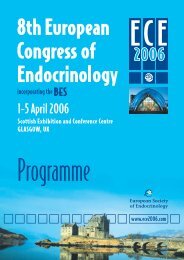
![The Endocrinologist | Issue 99 [PDF] - Society for Endocrinology](https://img.yumpu.com/48213777/1/184x260/the-endocrinologist-issue-99-pdf-society-for-endocrinology.jpg?quality=85)
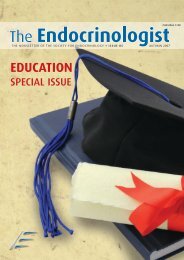
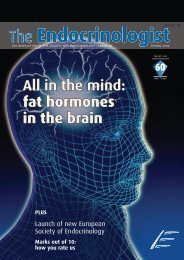
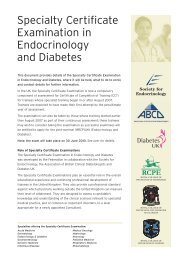
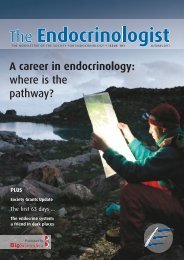

![The Endocrinologist | Issue 97 [PDF] - Society for Endocrinology](https://img.yumpu.com/40840065/1/184x260/the-endocrinologist-issue-97-pdf-society-for-endocrinology.jpg?quality=85)

